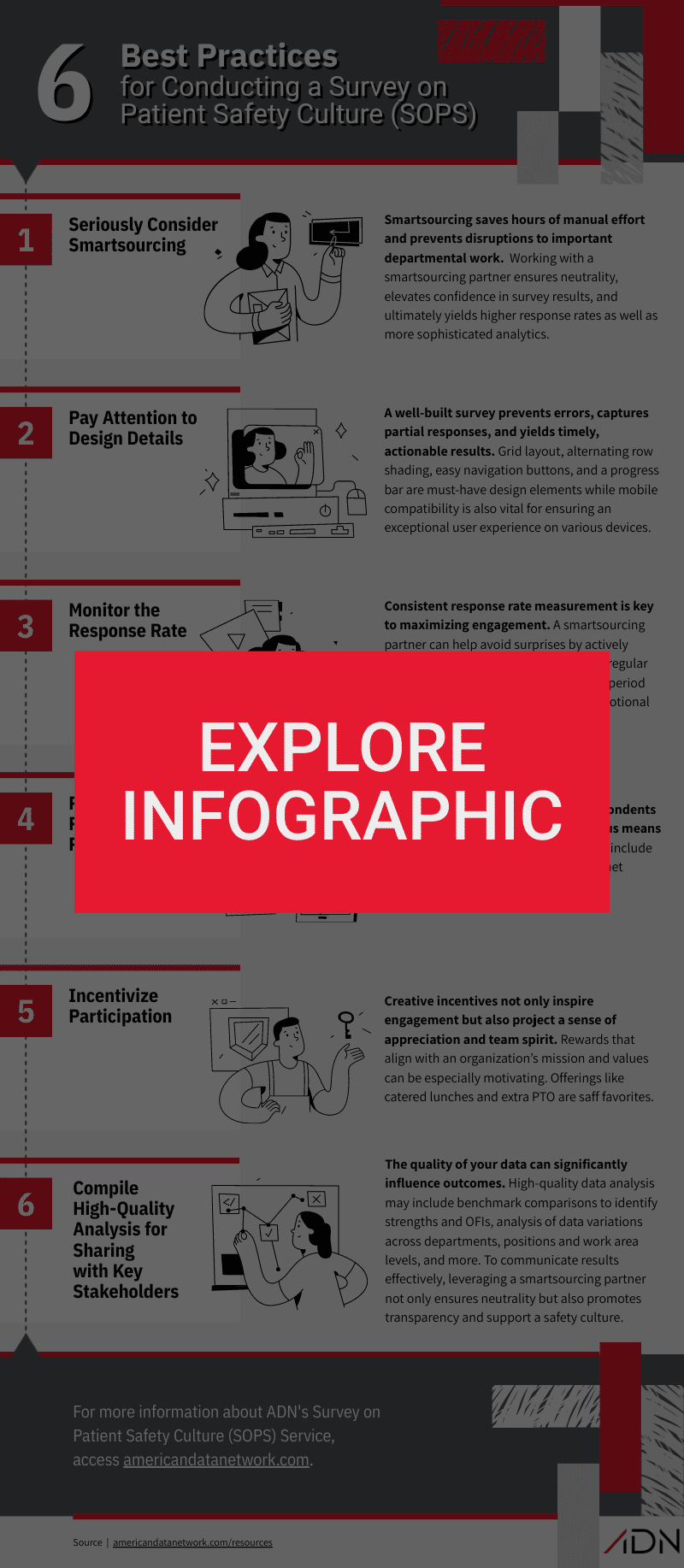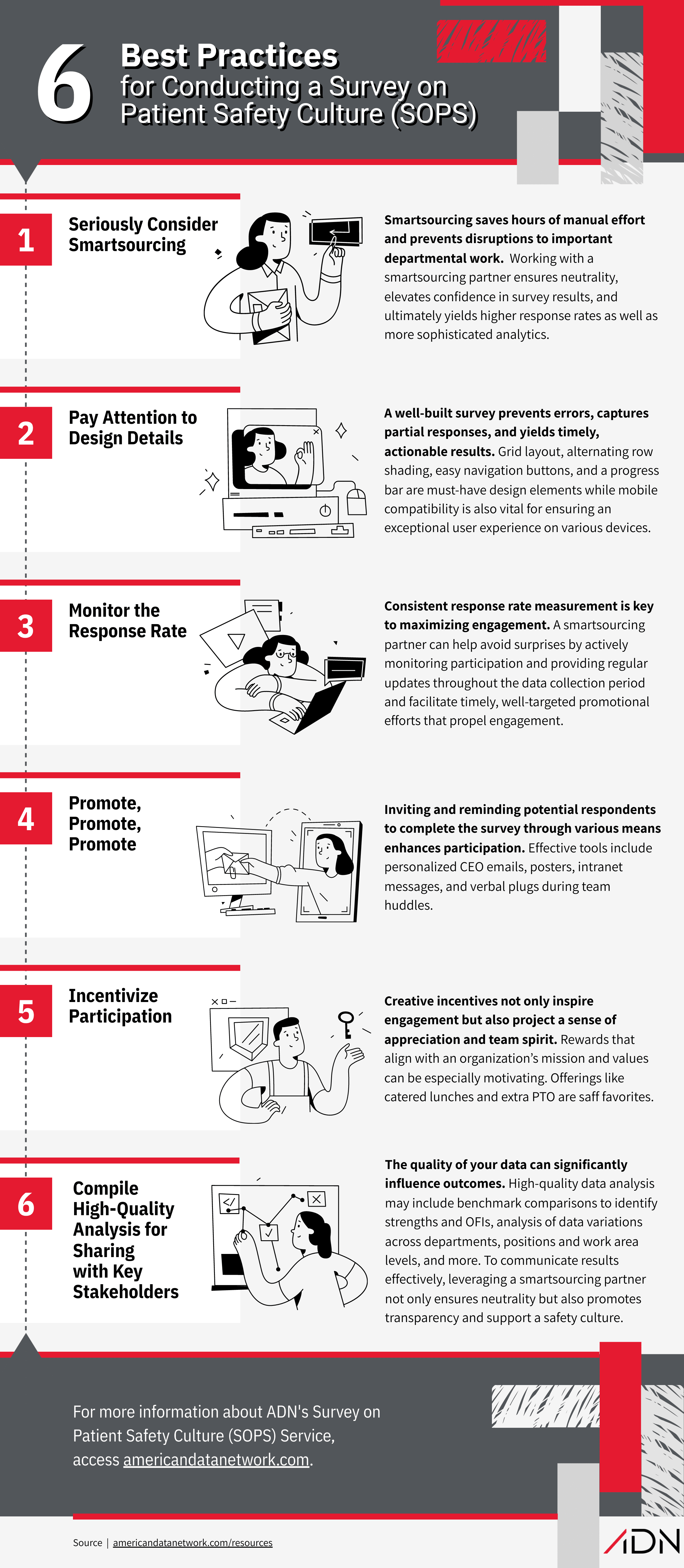What is SOPS®?
The Survey on Patient Safety CultureTM (SOPS®), developed by the Agency for Healthcare Research & Quality, helps hospitals, medical offices, and other healthcare organizations understand how providers and staff perceive aspects of their culture of safety.
Organizations use the SOPS® Assessment tool to:
- Raise staff awareness about patient safety.
- Assess the current status of patient safety culture.
- Identify strengths and areas for patient safety culture improvement.
- Examine trends in patient safety culture change over time.
- Evaluate the cultural impact of patient safety initiatives and interventions.
Table of Contents
- Best Practice #1: Give Due-Diligence Consideration to Outsourcing
- Best Practice #2: Focus on Effective Survey Design
- Best Practice #3: Actively Monitor Response Rates
- Best Practice #4: Promote Consistently Across Multiple Channels
- Best Practice #5: Incentivize Participation Effectively
- Best Practice #6: Compile High-Quality Analysis for Key Stakeholders
All your efforts to create a High Reliability Organization are ineffective if patient safety is not embraced at every level, from system to individual. The most effective way to measure and quantify your patient safety culture, and to identify problem areas, is by asking.
One of the most vetted measurement tools for this is the Survey on Patient Safety CultureTM (SOPS®) developed by the Agency for Healthcare Research and Quality (AHRQ).
Since its release in 2004, the AHRQ survey tool has gained significant attention, particularly as accreditation organizations like The Joint Commission (TJC) and public-scoring watchdogs like Leapfrog have increasingly emphasized its use.

At the end of 2018, TJC amended its survey process expectations for Patient Safety Culture Assessment.
- An organization will be expected to include its most recent Safety Culture Survey with the required documents listed in the Survey Activity Guide. The surveyors will want to review this prior to the opening conference (or as early in the survey process as possible).
- Surveyors will be tracing safety culture as a part of other survey activities and asking questions to assess safety culture. See Table 2 for sample questions for assessing a safety culture.
Leapfrog also incorporates Patient Safety Culture Surveys into its Hospital Safety Grade scoring criteria.
- “Hospitals can earn up to 120 points for measuring culture of safety, providing feedback to staff, and creating new plans to prevent errors.”
However, the AHRQ’s survey is not a one-size-fits-all process. The flexibility — how often to survey, who to survey, how to survey, and what to do with the results — recognizes the enormous variations in size and resources of patient-care organizations. But it also means a large number of decisions have to be made in-house.
For further insights on implementing these surveys, explore our hospital survey on patient safety culture guide.
Here are 6 best practices for conducting your next SOPS® to both fulfill accreditor and watchdog expectations and, more importantly, to make the process pay off in the form of an improved safety culture within your organization.
Best Practice #1: Give Due-Diligence Consideration to the Benefits of Outsourcing Survey Administration and Analysis
The ongoing healthcare staffing crisis, exacerbated since the pandemic, continues to impact many organizations. Even if your team previously managed the survey process in-house, your current capacity might have changed. If it’s been a few years since your last Survey on Patient Safety Culture (SOPS®), you may hesitate to take it on, especially with the AHRQ’s User Guide for Hospital SOPS® Version 2.0 outlining a 10-week timeline for planning, conducting, and analyzing the survey.
Some benefits to outsourcing are obvious – the process doesn’t interrupt your normal duties and projects, and you don’t have to reinvent the tools or train someone in-house for a process that only happens every other year.
For more insights into the advantages of safety culture surveys, check out our detailed article here.
Some are less obvious – the right outsourcing partner can help you (1) achieve much higher response rates that enrich the results, and (2) receive a more sophisticated and enlightening analytics report faster than you might otherwise. Our team turns the report around in less than 30 days.
AHRQ points out several benefits of using an outsourcing partner in the User Guide:
- Working with an outside vendor may help ensure the neutrality and credibility of your results.
- Staff may feel their responses will be more confidential when their surveys are returned to an outside vendor.
- Vendors typically have experienced staff to perform all necessary activities and tasks. A professional and experienced vendor may be able to provide your hospital with better quality results faster than if you were to do the tasks yourself.
Given these advantages and the affordability of outsourcing, it’s worth exploring this option before committing substantial internal time and resources to the administration of the SOPS®. To explore ADN’s Survey on Patient Safety Culture Service visit our service page.

Best Practice #2: Focus on Effective Survey Design
The pitfalls of a poorly designed online survey are so numerous that AHRQ produced a webinar on best practices as a companion to the SOPS® User Guide. When conducting a Survey on Patient Safety Culture, proper survey design is crucial to ensuring accurate and actionable data.
Online surveys have largely replaced paper-based methods due to their numerous advantages: online surveys prevent participants from selecting multiple answers for a single question; capture incomplete responses; and, most appealing, online survey responses are automatically compiled, resulting in actionable results within days rather than months.
Key design elements to prioritize include:
- Proper Grid Layout: A well-structured grid ensures clarity and consistency.
- Alternating Row Shading: This helps respondents smoothly navigate answer options, minimizing errors.
- Intuitive Navigation: Include easy-to-use buttons that allow respondents to move forward or backward through questions.
- Progress Indicators: Adding a progress bar motivates users to complete the survey.
- Mobile Optimization: Ensure the survey is user-friendly on mobile devices, not just desktops, to increase accessibility and response rates.
Best Practice #3: Actively Monitor Response Rates
One of the biggest advantages of online surveys over paper-based methods is the ability to track responses in real time. However, this benefit is lost if no one monitors the data until the survey period ends. To maximize the effectiveness of your Survey on Patient Safety Culture, it’s essential to keep a close eye on response rates throughout the survey process.
A reliable outsourcing partner can provide consistent updates, ensuring that you have the data you need to make adjustments. For example, American Data Network supplies response rate updates at least twice a week, broken down by the overall facility and individual departments. This allows for targeted promotional efforts, such as department huddles or staff meetings, to encourage participation and boost response rates proactively. Your response rate should never be a last-minute surprise.
Best Practice #4: Promote Consistently Across Multiple Channels
Even a well-designed Survey on Patient Safety Culture can experience low response rates without a consistent, multi-channel approach to promotion. It’s crucial to encourage, incentivize, and remind employees and other respondents throughout the survey period to maximize participation.
Effective promotion methods include:
- Personalized Emails: Messages from senior leadership, such as the CEO, have a higher impact and encourage engagement.
- Posters: Place visual reminders in common areas like break rooms and hallways.
- Verbal Reminders: Mention the survey during routine staff huddles to maintain visibility.
- Intranet Links: Provide easy access through your organization’s intranet.
If you choose to partner with American Data Network, our service includes a sequence of pre-written email templates with proven distribution schedules and timing to optimize engagement. For additional strategies on building and promoting your safety culture survey, refer to our hospital survey on patient safety culture guide.
Best Practice #5: Incentivize Participation Effectively
Offering meaningful incentives can significantly boost response rates for your Survey on Patient Safety Culture. Targeted rewards for departments achieving the highest response rates are typically more effective than random individual prizes, as they encourage team collaboration and competition.
The incentives should align with your organization’s commitment to patient safety and demonstrate its importance. Examples include:
- An Extra Day of Paid Leave: A powerful motivator that shows appreciation for staff engagement.
- Catered Meals: Organize a lunch or dinner to celebrate the participating team’s effort.
- Combination of Rewards: Combining different incentives, such as a day off and a catered meal, can further motivate staff.
Through experience, our team has learned some creative and motivating incentives that we share with clients.
Best Practice #6: Compile High-Quality Analysis for Key Stakeholders
The value of your Survey on Patient Safety Culture lies not just in data collection but in the quality of the analysis you provide. A thorough and insightful analytics report can turn a sea of raw data into actionable information. Below are some best practices for conducting a survey on patient safety culture and transforming the results into meaningful insights.
- Compare to External Benchmarks: It’s crucial to understand your facility’s performance in context. Compare your results with external benchmarks, like those from the AHRQ SOPS® databases, to identify strengths and areas for improvement. When partnering with American Data Network (ADN), the comprehensive report includes these comparisons, an executive summary, and a detailed breakdown of the data to help communicate findings effectively to stakeholders.
- Analyze Differences at Various Levels: Examine variations from baseline and compare results across departments, position titles, and work areas. Identifying not just areas for improvement but also top-performing groups can offer valuable lessons. By exploring the subculture of high-performing teams, you can uncover practices that might be replicated elsewhere.
- Leverage Unstructured Data: Don’t overlook the insights hidden in narrative responses. Coding and analyzing open-ended replies can reveal key themes, ensuring you extract maximum value from your survey data. For more techniques on handling unstructured data, our hospital survey on patient safety culture guide offers detailed strategies.
- Disseminate Findings at All Levels: While senior leadership may be the primary audience, sharing survey results across various levels of the organization fosters transparency and promotes organizational learning. By disseminating findings, strengths, and opportunities throughout the organization, you demonstrate that data collection leads to action and improvement, building greater buy-in across teams.
- Facilitate Multi-Disciplinary Feedback Sessions: The frontline staff have an undeniable role in event detection and reporting but can have an even greater impact when their intimate knowledge of internal systems is leveraged in the PDSA cycle. Frontline can serve as subject matter experts to help identify and define cause-and-effect relationships. When analyzing survey results by work areas or position titles or themes, a cross-discipline team will be able to contribute unique perspectives that uncover or explain trends seen within the survey data. By including representation from all involved disciplines and levels, the team will likely be able to add more context and better match problems with actions and interventions.
- Integrate Survey Findings with Other Safety Data: Analyze survey results alongside other available data, such as internal event reports and public safety scores, to gain a holistic view. Some SOPS® questions provide insight into existing safety interventions, like education programs, event reporting systems, and team communication. Evaluating these connections informs improvement efforts and helps allocate resources effectively. Our high reliability organizations guide offers additional strategies for integrating multiple data sources to enhance safety culture.
For further detailed insights on implementing and analyzing surveys, check out our national patient safety goals guide to understand effective strategies for connecting survey data with broader safety initiatives.
To maximize the impact of your Survey on Patient Safety Culture (SOPS®), it’s essential to implement these best practices with a strategic approach. By focusing on effective survey design, active monitoring, multi-channel promotion, and high-quality analysis, you can drive meaningful improvements in your organization’s safety culture. For expert assistance and a seamless survey experience, consider partnering with American Data Network. Our SOPS® service provides comprehensive support, from survey administration to detailed analysis, helping you turn survey data into actionable insights that elevate patient safety standards.






